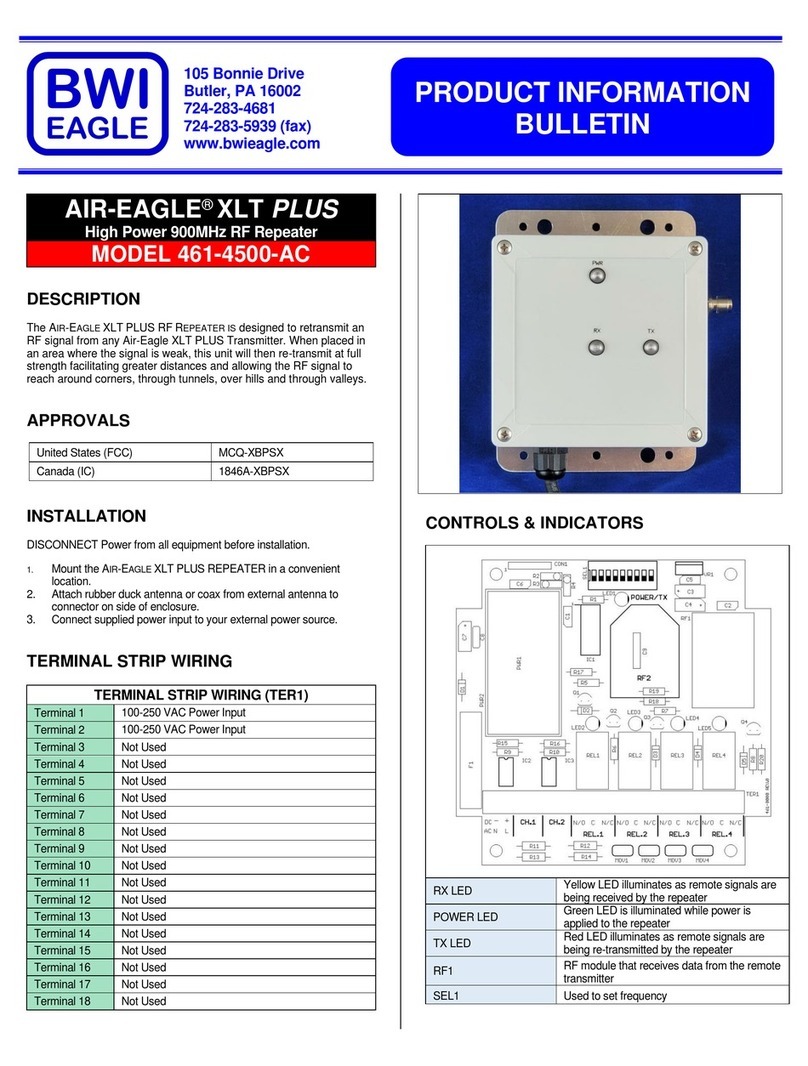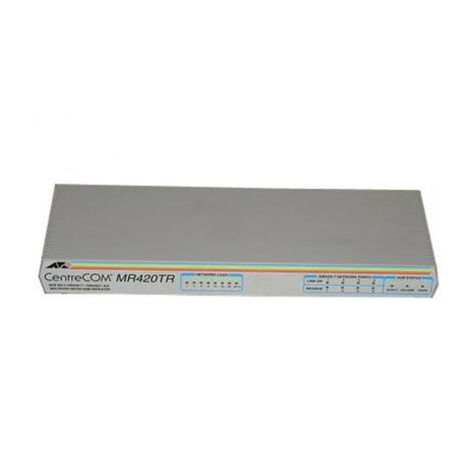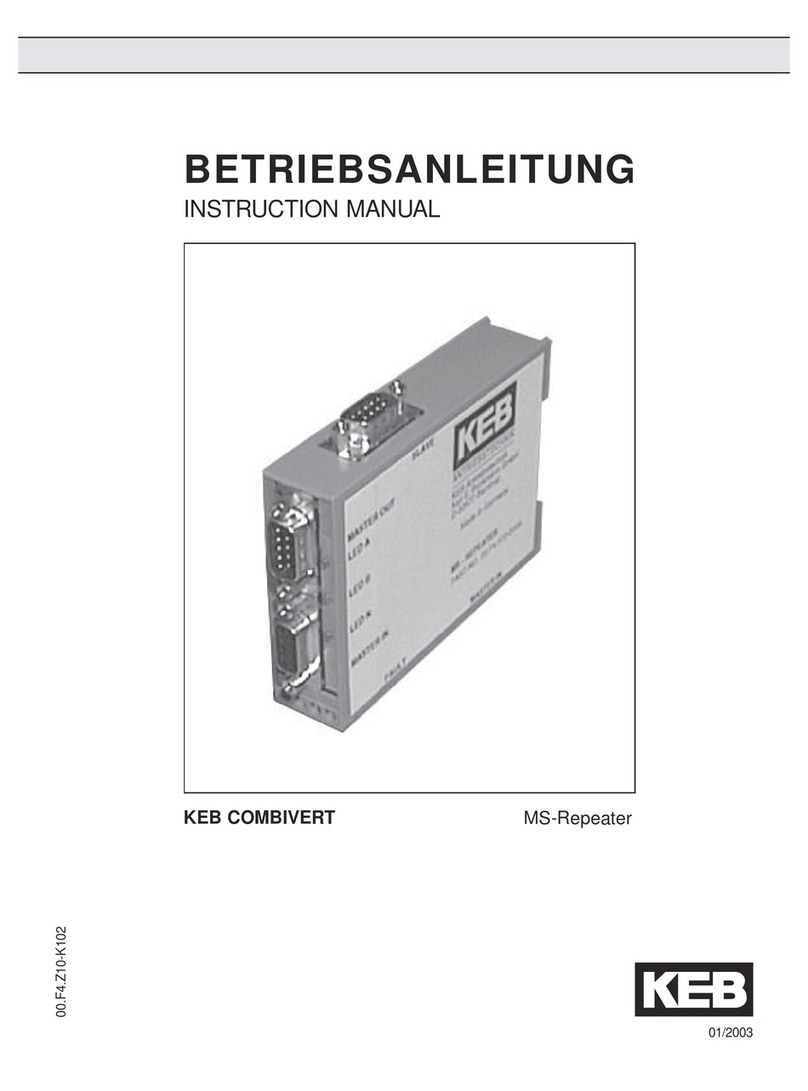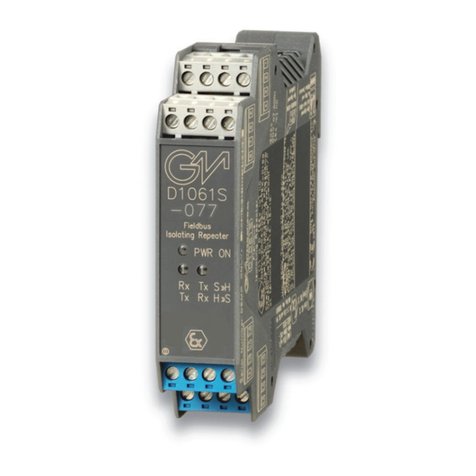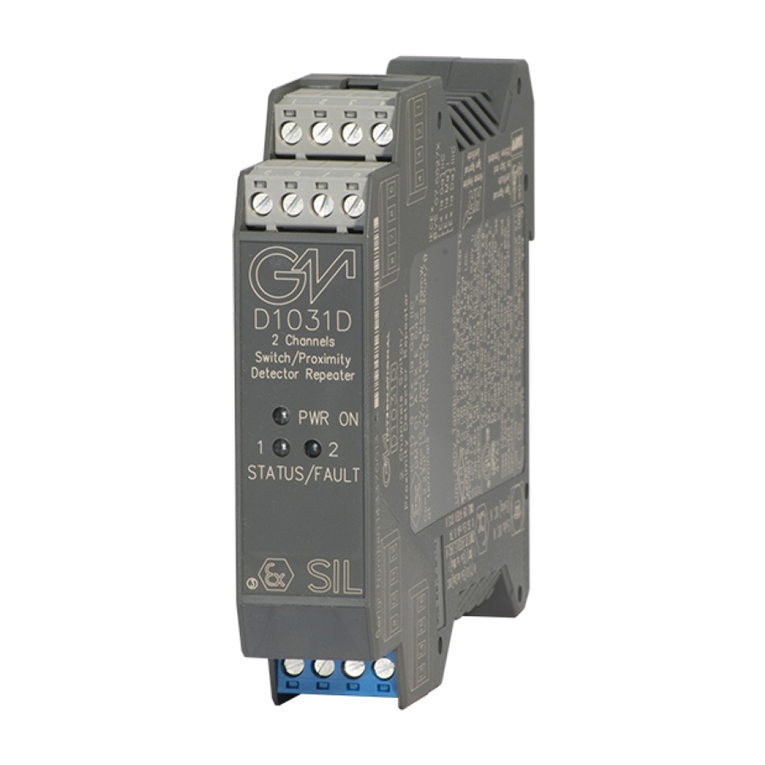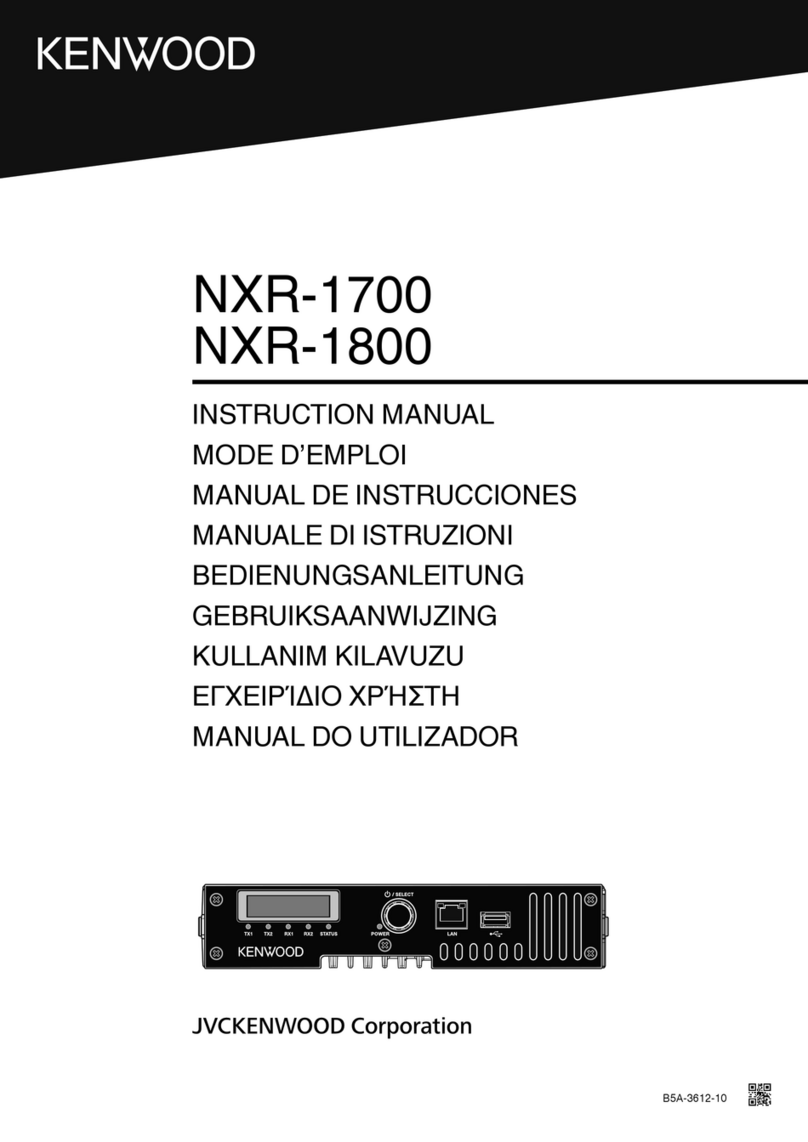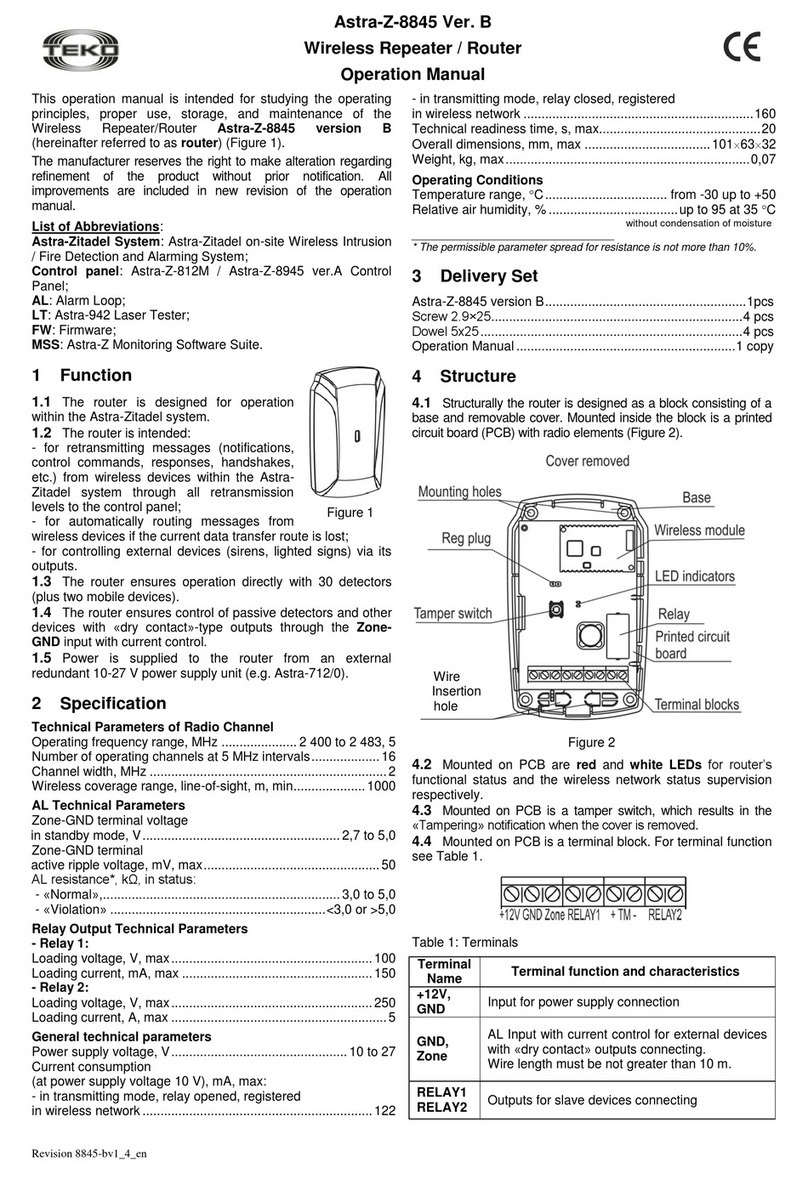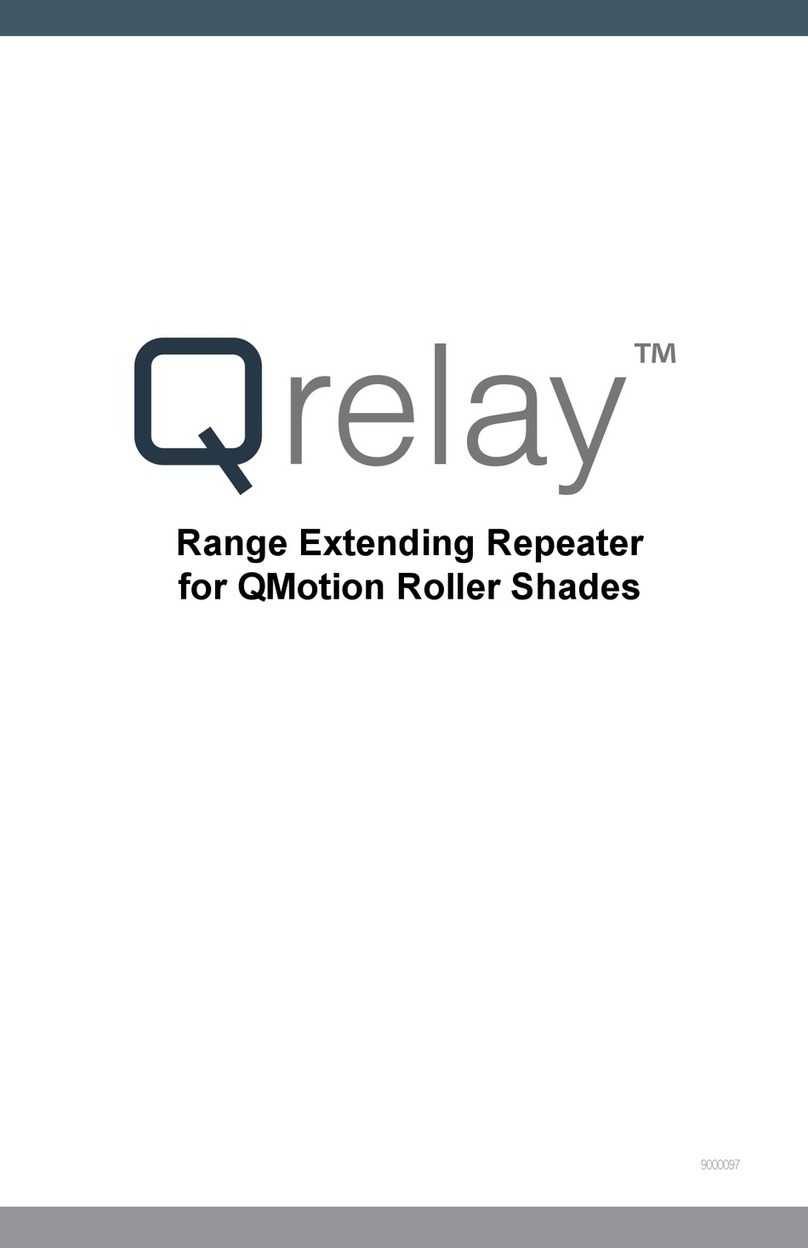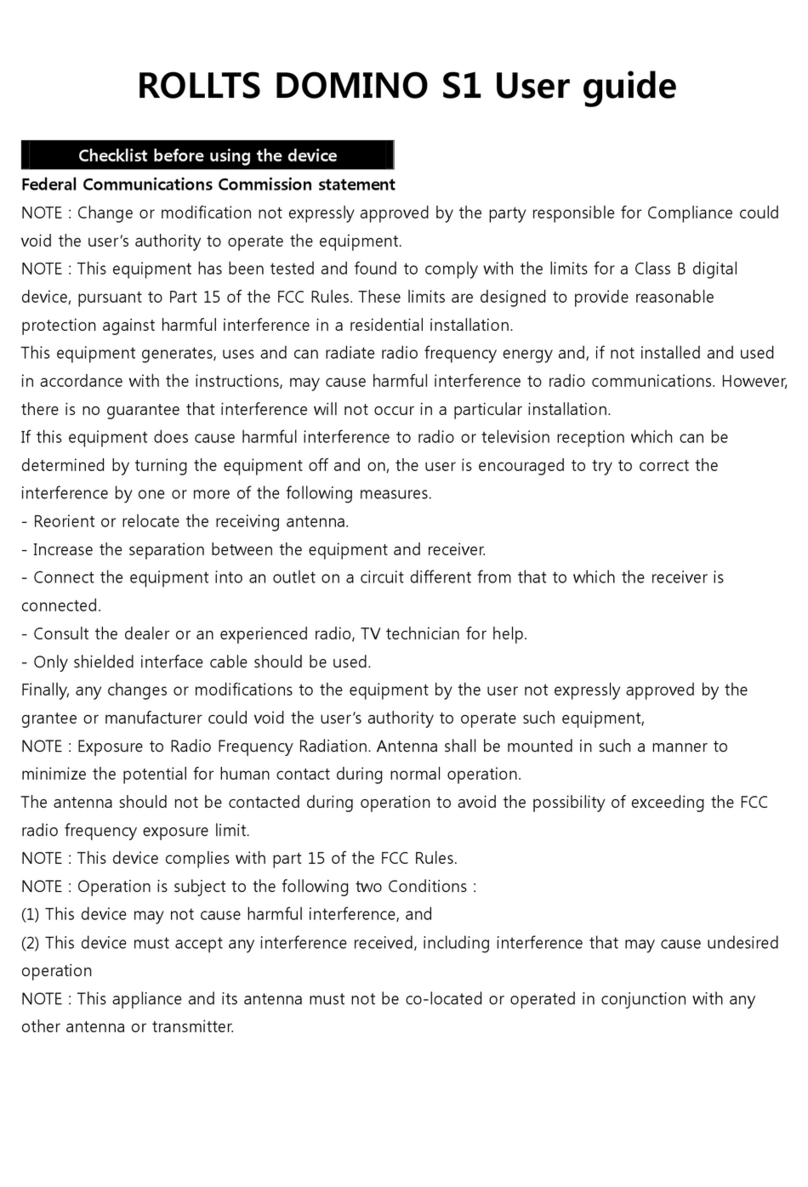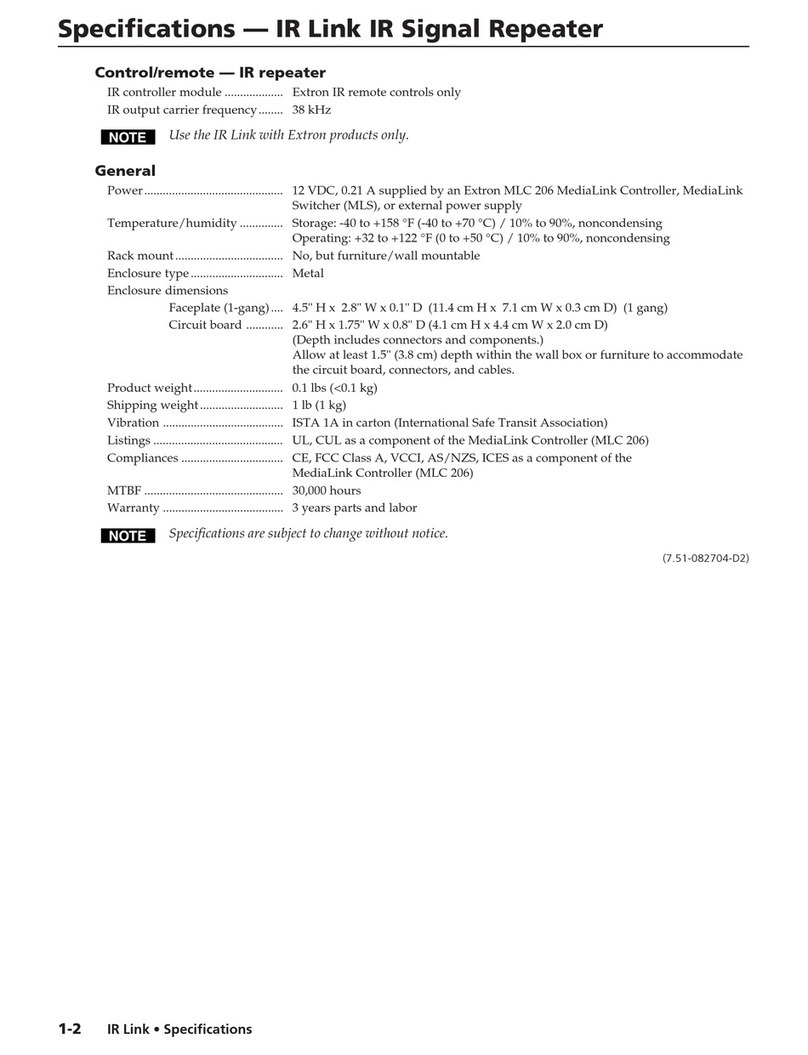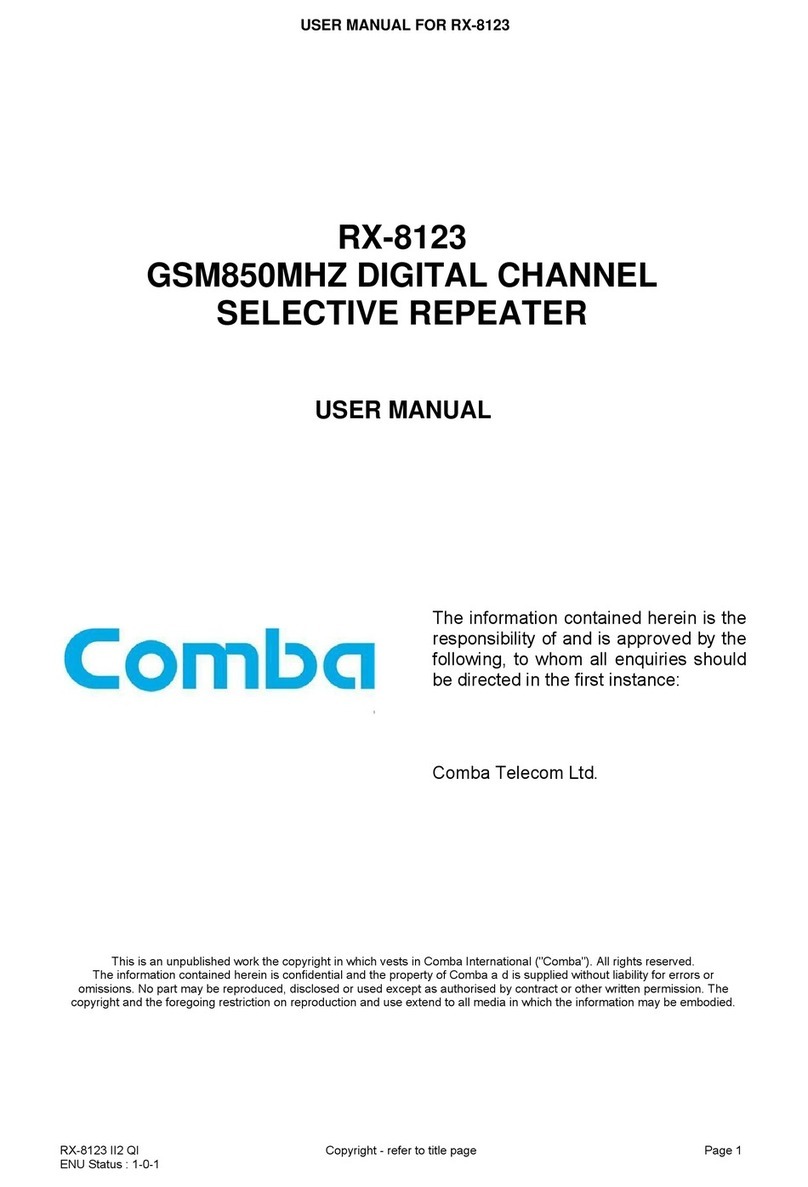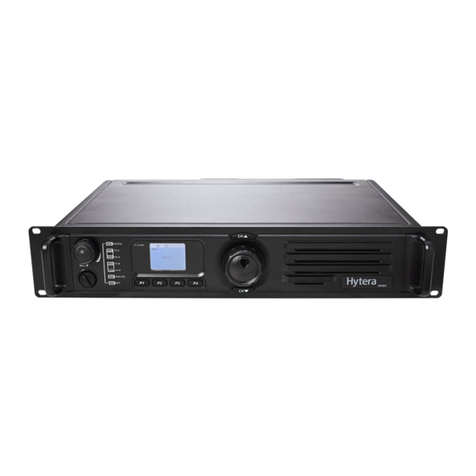Vivint V-RPTR1-345 User manual

4931 N 300 W Provo, UT
The
Vivint 345 MHz Repeater (RPTR1) is a receiver/transmitter device with an internal antenna
that
retransmits 345 MHz signals of sensors in a Vivint wireless home security and automation
system.
It does this by listening for alarm, status, and control signals from 345 MHz wireless
sensors (i.e., motio
n detectors, door/window sensors, fire/smoke and CO detectors, etc.), and
repeating
those signals to the control panel.
The 345 MHz Repeater
includes supervisory features so it can report relevant current status
information
such as AC power loss, low battery, bad battery, or loss of supervision.
The RPTR1 can repeat
signals from Vivint, 2GIG/Linear, and Honeywell 345 MHz sensors and
devices
. Only one 345 MHz Repeater can be installed per system.
The repeater
device contains a rechargeable battery that can provide up to 30 hours of backup
standby power when primary (ex
ternal) power is lost.
This document includes installation
, usage, and test instructions, as well as technical
specifications and regulatory
declarations.
345 MHz Repeater
(V
-RPTR1-345)
Ins
tallation Instructions
The repeater device can be installed
(i.e., mounted) by either a Vivint technician or a
homeowner
/customer by following the steps outlined below.
Mounting
the repeater device:
1. Remove the front cover by gently lifting the cover piece from the main body.
2. Connect the provided external power supply to the back of the repeater device
,
and push the cable snugly into the slot (under the cable retention tabs) so that
the device can be mounted flat against the surface of the wall.
3. Mount the repeater in the selected location (see Installation Tips). Use the
single round screw hole at the top of the device to insert the screw. Make sure
to use a screw anchor in the wall, and tighten the screw to securely attach the
repeater. Because the battery is on the left, the repeater leans slightly to the
left. There is an extra piece of adhesive tape that ships with the product that
can be attached behind the lower portion of the repeater to keep it anchored
and centered (if desired).
4. Plug the external power supply into an unswitched wall outlet. This turns on
the repeater.
5. Remove the battery pull tab in order to activate the backup battery.
(NOTE: The solid green PWR light indicates the repeater is receiving power
from the external power supply. It will not light up when only the backup
battery is providing power. The blinking red TX light indicates the repeater is
transmitting signals between the system sensors and the control panel.)
6. Replace the front cover by pressing it directly onto the mounted repeater
casing and pushing gently until it clicks into place indicating it is securely closed
.
Quick Reference
Front View (Cover Off):
PRINT INSTRUCTIONS: REFERENCE SHEET V-RPTR1-345 P/N 77-600007-001 REV 1.3 | INK: BLACK |
MATERIAL:
20 LB MEAD BOND | SIZE: 8.50" X 11.00" SCALE 1:1 | FOLDS: BI-FOLD VERTICAL, BI-FOLD
HORIZONTAL (TO FIT IN BOX)
Back View:
INSTALLATION TIPS:
•Install the repeater in a location near an AC power outlet (unswitched wall outlet).
•To maximize wireless performance, the repeater should be installed on a wall in
the portrait orientation, and located generally halfway between the most distant
system sensors (e.g., sensors that are indicating low signal strength) and the
control panel.
•Install only one repeater device per Vivint system.

Battery
Activation
The battery for the
repeater is a non-serviceable rechargeable lithium-ion battery that is pre-installed inside the device. The battery provides backup power (for up to 30
hours)
when the power supply is disconnected and/or during a power outage. Do not remove or tamper with the battery in any way. To activate the battery:
1. Remove the battery pull tab to create a contact between the battery and the repeater circuit board. The blinking red TX light indicates the repeater is transmitting
signals. From a non-powered state, the battery will not engage until external power is applied.
2. Plug the external power supply into the connector on the back of the device. Plug the AC/DC power supply into an AC power outlet. The solid green PWR light
indicates power is being provided (not backup battery power).
Specifications
Wireless Signal Range
350 feet (106.7 m), open air
Batteries
Lithium-Ion Cylindrical 3.6 V 2200 mAh (non-servicable battery)
Battery Life
5-10 years under normal usage
Transceiver Frequency
345 MHz
Code Outputs
Supervisory, Low Battery, Bad Battery, Wall Adapter Disconnect
Supervisory Interval
70 minutes (4 hours for panel to report supervision failure)
Operating Temperature Limits
32° to 120°F (0° to 49°C)
Relative Humidity
5-95% Non-Condensing
Installer Test
Remove the
repeater front cover, and then press and release the test switch adjacent to the red TX LED indicator to transmit a signal from the repeater to the control panel
to confirm proper operation. Test the sensors and detectors furthest from the control panel by triggering the sensor or pre
ssing a test or tamper button on each device.
© 2021 Vivint Inc. All Rights Reserved.|www.vivint.com |1-800-216-5232 | Device M/N: RP01 | Doc P/N: 77-600007-001 Rev. 1.3
FCC and Industry Canada Regulatory Declarations*
CAUTION!
Unauthorized changes or modifications could void the user’s authority to operate the equipment.
This device has been tested and found to comply
with the limits for a Class B digital device, pursuant to Part 15 of FCC Rules and Industry Canada license-exempt RSS standard(s).
Operation is subject to the following two conditions:
(1)This device may not cause harmful interference, and
(2)This device must accept any interference received, including interference that may cause undesired operation of the device.
These limits are designed to provide reasonable protection against harmful interference in a residential installation. This e
quipment generates, uses, and can radiate radio
frequency energy and, if not installed and used in accordance with the instructions, may cause harmful interference to radio communications. However, there is no guarantee that
interference will not occur in a particular
installation. If this equipment does cause harmful interference to radio or television reception, which can be determined by turning the
equipment off and on, the user is encouraged to try to correct the interference by one or more of the following measur
es:
•Reorient or relocate the receiving antenna.
•Increase the separation between the equipment and the receiver.
•Connect the equipment into an outlet on a circuit different from that to which the receiver is connected.
•Consult the dealer or an experienced radio/television technician for help.
PRUDENCE!
Changements ou modifications pourraient annuler le droit de l'utilisateur à utiliser l'équipement non autorisées.
Conformément à la réglementation d'Industrie Canada, le présent émetteur radio peut fonctio
nner avec une antenne d'un type et d'un gain maximal (ou inférieur) approuvé pour
l'émetteur par Industrie Canada. Dans le but de réduire les risques de brouillage radioélectrique à l'intention des autres ut
ilisateurs, il faut choisir le type d'antenne et son gain de
sorte que la puissance isotrope rayonnée équivalente (p.i.r.e.) ne dépasse pas l'intensité nécessaire à l'établissement d'une
communication satisfaisante.
Le présent appareil est conforme aux CNR d’Industrie Canada applicables aux appareils rad
io exempts de licence. L’exploitation est autorisée aux deux conditions suivantes:
(1) l’appareil ne doit pas produire de brouillage, et
(2) l’utilisateur de l’appareil doit accepter tout brouillage radioélectrique subi, même si le brouillage est susceptible d’en compromettre le fonctionnement.
Ces limites sont conçues pour fournir une protection raisonnable contre les interférences nuisibles dans une installation rés
identielle. Cet équipement génère, utilise et peut
émettre une énergie de radiofréquence e
t, s'il n'est pas installé et utilisé conformément aux instructions, il peut causer des interférences nuisibles aux communications radio.
Cependant, il n'existe aucune garantie que des interférences no se produiront pas dans une installation particulière.
Si cet équipement provoque des interférences nuisibles à la
réception radio ou télévision, ce qui peut être déterminé en mettant l'équipement hors et sous tension, l'utilisateur est enc
ouragé à essayer de corriger l'interférence par une ou
plusieurs des me
sures suivantes:
•Réorienter ou déplacer l'antenne de réception.
•Augmentez la distance entre l'équipement et le récepteur.
•Connecter l'équipement à une sortie sur un circuit différent de celui sur lequel le récepteur est branché.
•Consulter le revendeur ou un technicien radio / télévision expérimenté pour de l'aide.
FCC ID:
2AAAS-RP01
IC ID:
10941A-RP01
**For complete regulatory compliance information, go to: vivint.com/fcc
WARNING! This battery is not servicable. Do not remove the battery cover. Improper handling of lithium batteries may result in heat generation, explosion, or fire,
which may lead to personal injury.
AVERTISSEMENT!Une mauvaise manipulation des piles au lithium peut conduire à la production de chaleur, une explosion incendie, ce qui peut entraîner des blessures.
Batteries must not be disassembled or disposed of in fire.
Disposal of used batteries must be made in accordance with the waste recovery and recycling regulations in your area.
Keep away from small children. If batt
eries are swallowed, promptly see a doctor.
Wireless Product Notice
Wireless communications hardware
provides reliable communication; however, there are some limitations which must be observed.
•The transmitters are required to comply with all applicable wireless rules and regulations. As such, they have limited transmitter power and limited range.
•Wireless signals may be blocked by radio signals that occur on or near the wireless operating frequencies.
Table of contents

